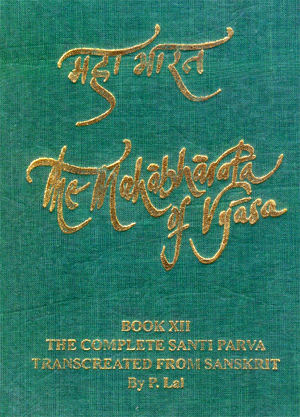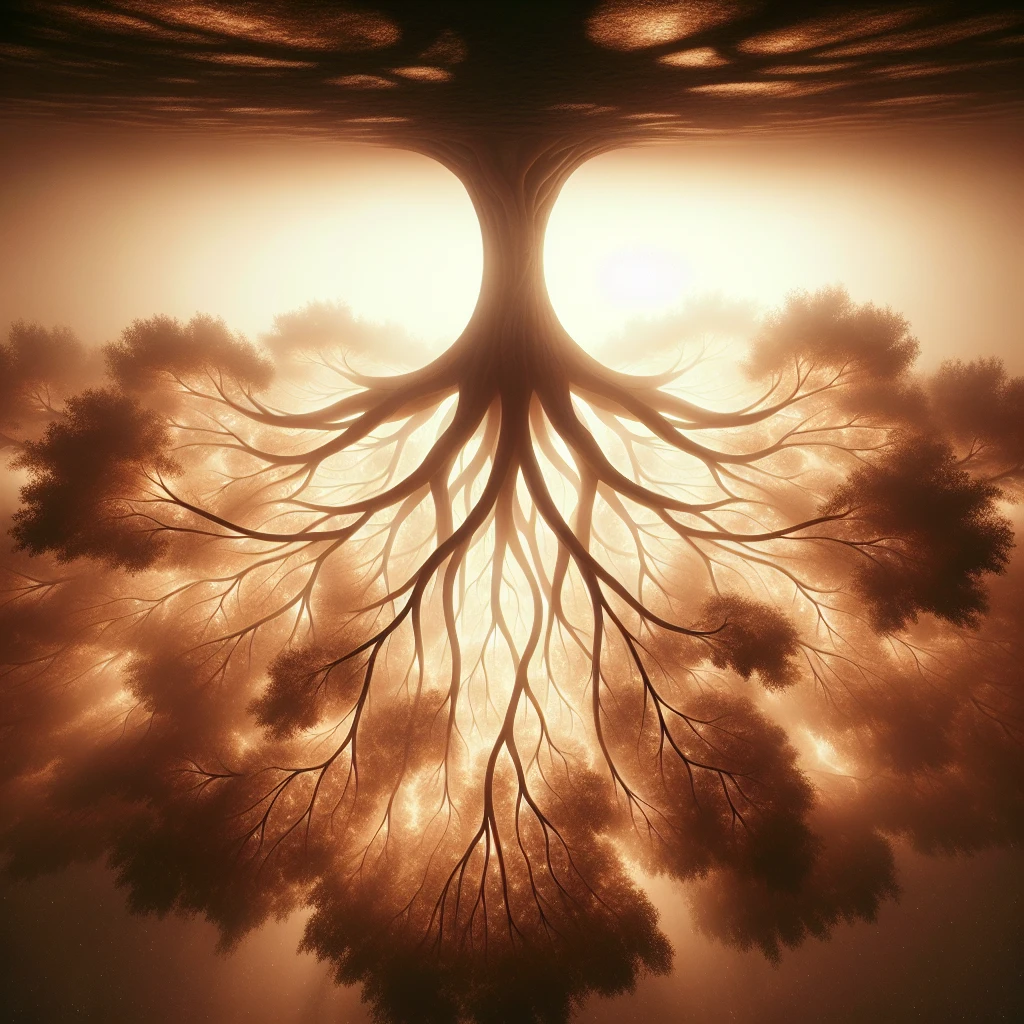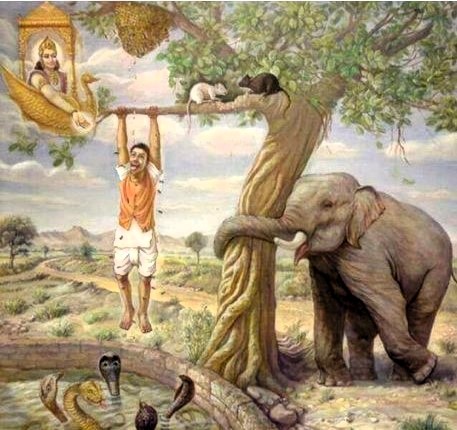P. Lal: The Mahabharata of Vyasa, Book XII, the Complete Shanti Parva Part 1 (“Raja-Dharma”), pp.1011, Rs.2000 (hardback), Rs. 1500 (flexiback), Writers Workshop, Calcutta.

The last part of the great epic of Bharata that Professor Lal, Padma Shri and Jawaharlal Nehru Fellow, succeeded in completing is now published. Devoted to the principles of governance (raja-dharma), it appears at a time most opportune when all principles have been cast to the winds and the polity of India is falling to pieces. Kiran Bedi’s tweet of 10th June 2012 on “Coalgate” shows how alive India’s great epic still is in our consciousness after millennia: “PMO clears Prime Minister. Did Dhritarashtra in Mahabharata not support Kauravas even after they attempted to disrobe Draupadi? Indian genes/culture? Or?” Soon after the Gujarat riots, Prime Minister Vajpayee’s only response to the public outrage had been to urge chief minister Modi to be mindful of “raja-dharma”. Unfortunately, today neither the legislature nor the executive is aware of what this phrase means. The availability of this transcreation should bridge that hiatus.
The holocaust of Kurukshetra is over; eighteen armies have been decimated. The cosmic design to rid over-burdened Prithivi of power-hungry warriors has been accomplished. Surely, for Yudhishthira, son of Dharma and the righteous king (Dharma-Raja), it is a time to celebrate the fulfillment of his mother Kunti’s dream to see her sons win back their inheritance. Instead, he is tormented by loss and guilt, confessing to the celestial sage Narada,
“motivated by greed
I committed this maha-murder
of my kith and kin…
what is it but defeat…?”
So, the chink in his armour of righteousness is the passion that has doomed the lunar dynasty down the ages: greed. He is particularly anguished over the killing of Karna, who knew he was the eldest Kaunteya while fighting his brothers who did not. We learn that his anger against Karna would dissipate when he looked at his feet which strangely resembled Kunti’s. What an inimitable Vyasan vignette! Hence Yudhishthira’s curse that women will never be able to keep a secret. Narada informs him of a great secret: it was in order to engender the war that “a friction-fostering foetus/was placed in a virgin womb”. So Karna’s role from the very beginning was that of the resentful bastard, like Edmund in King Lear, backing up Duryodhana against the Pandavas. Narada narrates key incidents in Karna’s life bringing out the multiple handicaps he suffered: disowned at birth, cursed by Parashurama and a Brahmin, the boon he gave Kunti, his gift of the armour and earrings that made him invulnerable, being branded half-a-chariot-hero by Bhishma, constant belittling by Shalya, Krishna ensuring that Arjuna never faced a fresh Karna. Narada mentions Karna defeated Jarasandha who gifted him Champa town in Anga which begs a question: if he were truly king of Anga, as Duryodhana had crowned him, how could Champa be Jarasandha’s to gift? We always find Karna in Hastinapura, never ruling in Anga. Was the investiture merely symbolic?
We find here interesting revelations regarding the society of those times. For instance, what was the status of atheism? Charvaka (after whom the doctrine of atheism is named) takes advantage of Yudhishthira’s guilt to berate him publicly. The Brahmins kill him, branding him a demon and friend of Duryodhana disguised as a mendicant. Again, Narada informs that king Rantideva killed over 20,000 cows to feed guests. So, the Vedic practise of slaughtering a cow for a special guest (who was therefore called “goghna”) continued into epic society. Vyasa tells that Uddalaka’s famous son Shvetaketu was actually begotten by a disciple on his wife on his guru’s orders. Uddalaka later renounced his son for having lied to Brahmins. Yajnas (sacrifices) are prescribed as essential for all four classes with the saving that the Shudra will not chant mantras. The three other classes are responsible for maintaining the Shudra. A Brahmin of ill character is equivalent to a Shudra and should be ostracized. It is one’s karma that makes dharma. The ruler must have a group of ministers taken from all sections of society: 4 Brahmins, 8 Kshatriyas, 21 Vaishyas, 3 Shudras, 1 bard expert in Puranas. Their qualifications are given in detail. Of them the ruler has a cabinet of eight, whose decisions must be announced to the public. Section 108 contains the famous verses, extolling them as the highest teaching:
“One’s father excels ten teachers, one’s mother surpasses ten fathers, indeed surpasses the world itself. There is no guru anywhere to equal a mother…you will gain this world by serving your father, the next world by serving your mother properly, and the world of Brahma by serving your guru…When a legitimate adult son fails to support his father and mother, his crime equals that of killing a foetus—that which is no greater wickedness.”
There is an uncompromising condemnation of those who discarding the three Vedas, their professions and families, don saffron robes and go begging with a three-pronged staff:
“but they are tied to the world,
because to them
begging is a profession…
Pure selfishness.
These shaven dunderheads,
flaunting the flag of dharma,
are hypocrites.”
It is also admitted that “the shastras are full of contradictions”, and that “The Vedas do not cover everything” (Section 109). Ascesis, tapasya, is extolled above sacrifices and it is clarified that this does not mean mortifying the flesh but is non-violence, truthfulness, self-control, compassion. Incidentally, there is never any mention of the Vedas as numbering more than three, which shows that the Atharva Veda was a post-Mahabharata composition. We are also told that originally the three Vedas were one. It is Vyasa who arranged them under separate names, as he did with the original Purana.
As with the secret cause of Karna’s birth, another fascinating sidelight comes in the tale of demon Damsha that takes forward the rape of Bhrigu’s wife Puloman related in the Adi Parva. We learn that the rapist was cursed by Bhrigu to be reborn as a vicious insect, and in that form he bored through Karna’s thigh, resulting in Parashurama’s curse.
To dissuade Yudhishthira from becoming a sannyasi, by turn arguments are presented by the brothers and Draupadi extolling earning of wealth (artha), the householder’s life, desire (kama) and punishment and justice (danda) as the principle preserving a polity. In the process, they even call Yudhishthira a fool! To console Yudhishthira for the loss of his progeny, Krishna narrates the account of 16 past kings of far greater stature who all died. This account, occurring also in the Drona Parva, is similar to the Old English “Deor’s Lament” in intention.
Once Yudhishthira has reconciled to kingship, Krishna sends him to Bhishma, lying on his bed of arrows, for instruction on governance, for with his death “you will see the setting of all knowledge.” Bhishma begins with a paean to Krishna in which he mentions the ten avatars, interestingly saluting Balarama as “the soul of Bhoga, enjoyment” and Krishna as “the soul of sport”, and mentioning Buddha as disciplining the anti-gods. The crucial importance of the ruler is repeatedly stressed:
“First find a raja.
Then get a wife.
Then wealth…
Without a raja
Your wife and wealth,
What good are they?”
The ruler’s cardinal duty is to ensure his subjects’ welfare first and last. Unless he conquers his own senses, he cannot conquer his foes. It is because he delights (ranjita) them that he is called “raja” and all dharmas depend on him. It is the ruler who shapes the nature of the age—Krita, Treta, Dvapara or Kali.
Much of what we know later as the Arthashastra is given here. Originally it was called “Danda-niti”, the principles of punishment. Composed of one lakh sections by Brahma, it was condensed by Shiva under the name “Vishalaksha” in ten thousand sections which Indra abridged in five thousand calling it “Bahudantaka”. Brihaspati reduced it to three thousand and that was further edited to one thousand sections by Shukra because of the decreasing life-span of humans.
Beginning with quotations from past savants and 8 stories on the origin and duties of the ruler, Bhishma narrates 19 tales on the core issues of ruling (repeatedly stressing impersonal administration of punishment, careful selection of advisers through fivefold tests and not trusting anyone completely), following up with 8 on what is to be done in extremity, and ending with 9 on expiating sins and the results of harming friends. The methodology adopted is Upanishadic question-and-answer between pupil and teacher. These make up the 173 sections of this tome in which sections 98 to 173 are in prose—the longest prose section in Vyasa’s narrative.
Vyasa narrates to Yudhishthira the “Ashma Gita” narrated to Janaka by the sage Ashma where the root causes of mental anguish are specified as either confused thinking or unexpected calamity, with attachment to material things as a related cause. We also find here the philosophy that is repeated in the Upanishads by Yajnavalkya:
“No one is anyone’s, no one
belongs to anyone but oneself.
Wife, and relative,
And friend—
All travelers, all passers-by
On the road of life…
Whoever you love, will leave you.”
Vyasa also repeats insights from the Gita regarding Time being the real slayer of the armies, and that
“Times are when dharma
starts looking like adharma,
and adharma like dharma.…
In special cases,
even stealing, lying and killing
can be dharma.”
As a telling example, the story of Vishvamitra justifying stealing dog-meat from an untouchable is told: “What is important is to stay alive” because only then can dharma be practiced! If problems arise regarding dharma, a committee of ten experts in the scriptures is to resolve them, or three teachers of dharma.
Vyasa declares that since Yudhishthira got involved in fratricide because of the wicked deeds of others, he is not at fault. There is no sin in killing even gurus who flout their calling because of greed (as with Drona). He advises Yudhishthira to enthrone the surviving kin of the rulers, including daughters if there are no sons, showing compassion to establish peace in the land. This is where the famous verse on when it is permissible to lie occurs which is repeated at least thrice in this parva: to save one’s life or another’s; for one’s guru’s sake; to win over a woman; to arrange a marriage. “Women, diamond and rain-water—these three are always pure.” Even an unfaithful woman becomes pure after her period.
From the standpoint of narrative art, a fresh frame has been introduced in this parva. The Mahabharata’s outermost frame is Sauti narrating it to Shaunaka and his sages in the forest of Naimisha. The next layer is the snake-sacrifice in Takshashila during which Vaishampayana narrates the epic to king Janamejaya in the presence of the author Vyasa, which is what Sauti heard. Now we have a series of concentric layers where several narrators tell Yudhishthira stories, of which the largest is Bhishma’s portion. Nested within Bhishma’s layer are so many tales, and tales-within-tales! The entire narrative structure reminds us of a Chinese Box or a Matroyshka.
Among these akhyanas (tales) are some that stand out. Such a one is Janaka’s queen quite unexpectedly berating him for wishing to abdicate, much as Draupadi does Yudhishthira. Others are animal fables that recur in Panchatantra.
Possibly the most fascinating of Bhishma’s many accounts is the conversation Krishna has with Narada. It is the only passage giving vent to the frustration Krishna experiences—something none of us would imagine, and which remains unknown to most of us who have not read the Shanti Parva fully. The mellifluous free verse transcreation communicates the emotions beautifully. Balarama, Gada, Pradyumna—all are engrossed with themselves, none helps Krishna. Among his quarrelling clansmen he is,
“like a mother of two gamblers:
I want one side to win
I do not want the other to lose.
And the result is that
I am at the receiving end of both.”
The bitter words of relatives “stir fire in my heart.” Narada, after pointing out that this is his own doing because they are all his own relatives, tells him of a weapon “not made of iron, a gentle but heart-piercing weapon” to wash clean their bitter tongues. Those of us who are interested can read section 81 to find out what it is.
The genocide of the warrior-class perpetrated by Parashurama is a significant story Bhishma tells to explain how the “kshatriya varna” had to be restored by Brahmins to protect the polity. The divine right of kings is not just a European and far-Eastern concept. Bhishma equates the ruler with the preserver Vishnu, explaining the sacred nature of his duties. The ruler is the god of fire when he scorches liars; the sun-god when he observes the people and ensures welfare; death when he kills criminals; Yama the judge when he punishes and rewards; the god of wealth Vaishravana when he collects taxes and remunerates. Bhishma also tells the tale of Vena to show that an unrighteous ruler is even killed or removed by the people. There is more than enough guidance available here for our own times—provided we are interested!
A bonus for the reader is the superlative introduction provided by the transcreator, packing into just two pages an amazing amount of profound insight, bringing home to 21st century society the lessons of the ancient past that never cease to be relevant. “Artha”, wealth, is indeed a basic goal of life, but it is not money but the meaning of money—trusteeship—that makes it worthwhile. Without benefiting others, how do I benefit myself? “Kama”, desire or pleasure is an essential ingredient of life, but what is important is to transform lust into love: “both are four-letter words; it’s our disciplined choice that changes one into the other.” Dharma is not just ritualistic religion but spiritual vision where differences of creed vanish. “Moksha” is not only escape from life, but transforming that into liberation for humanity at large. What a world of meaning has been concentrated into these few printed words!
At the end are detailed reviews of the Shalya Parva transcreation and the set of ten DVDs of readings by Prof. Lal from the Adi Parva telecast on Tara TV. Prof. Lal’s rebuttal of Dr. Amartya Sen’s misconception regarding what Krishna says in the Gita is also printed. This volume leaves the discourse on Moksha and the Anushasana Parva untranslated.
Thus ends the massive enterprise a single poet and transcreator of remarkable genius embarked upon in 1968, making transcreating Vyasa the major work of his life, having also covered, before his departure, the lovely ninth and tenth books of the Bhagavata Purana.

